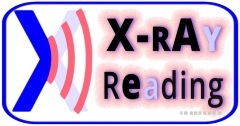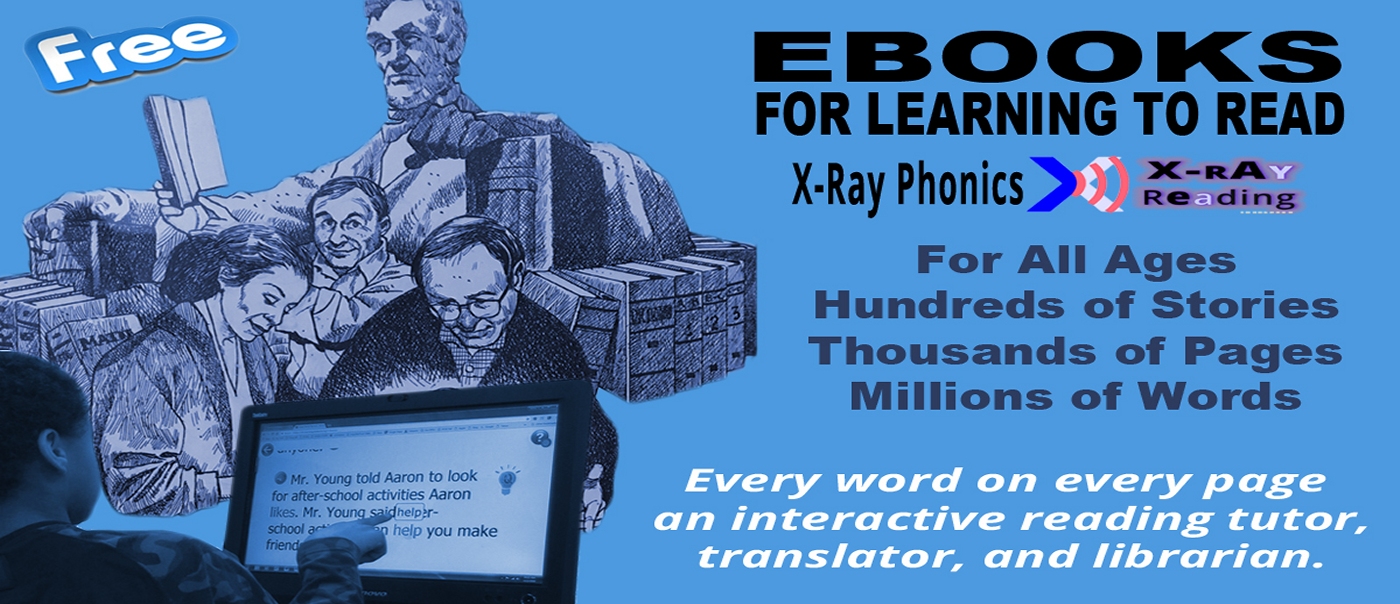 See the letter-sound patterns inside of words as you hear them.
See the letter-sound patterns inside of words as you hear them.
Listen to passages or entire Ebooks while learning to connect the sub-sounds you hear in words with their phonical and morphological structures. 
 X-Ray Reading with X-Ray Phonics
X-Ray Reading with X-Ray Phonics

 X-Ray Phonics is like a 21st century “bouncing ball” that highlights the inner structure of each word it bounces on. It makes possible X-Ray Reading, a new way of learning to associate the visual patterns seen in written words with the sound patterns heard when they are spoken.
X-Ray Phonics is like a 21st century “bouncing ball” that highlights the inner structure of each word it bounces on. It makes possible X-Ray Reading, a new way of learning to associate the visual patterns seen in written words with the sound patterns heard when they are spoken.
 X-Ray Phonics – is not meant to replace “science-based instruction”. Instead, it is meant to enhance audiobook accommodation and audio based assistive reading technologies. As they are, when these technologies “do the reading”,they compensate for improficient reading and build vocabulary and knowledge, but they do so at the expense of short-circuiting the process of improving reading. X-Ray Phonics compensates for improficient reading skills while at the same time helping to improve them.
X-Ray Phonics – is not meant to replace “science-based instruction”. Instead, it is meant to enhance audiobook accommodation and audio based assistive reading technologies. As they are, when these technologies “do the reading”,they compensate for improficient reading and build vocabulary and knowledge, but they do so at the expense of short-circuiting the process of improving reading. X-Ray Phonics compensates for improficient reading skills while at the same time helping to improve them.
 How to Use: click any X-Ray Reading button to hear and watch a passage. To learn more about a word click on it (and click it again as needed) and the X-Ray Reading Assistant will immediately appear (try it now).
How to Use: click any X-Ray Reading button to hear and watch a passage. To learn more about a word click on it (and click it again as needed) and the X-Ray Reading Assistant will immediately appear (try it now). 
 Simple Settings: You can easily change reading speeds and voices,(and access other settings and functions), by clicking on the Help and Settings button at the top right of each page
Simple Settings: You can easily change reading speeds and voices,(and access other settings and functions), by clicking on the Help and Settings button at the top right of each page .
.


 The best way to learn about how easy to use and powerfully helpful X-Ray Reading is,is simply to try it yourself. Click here for an index of Ebooks or here to visit the Pre-K 12 Magic Ladder Library. Then, just look for the little X-Ray Phonics icon
The best way to learn about how easy to use and powerfully helpful X-Ray Reading is,is simply to try it yourself. Click here for an index of Ebooks or here to visit the Pre-K 12 Magic Ladder Library. Then, just look for the little X-Ray Phonics icon  next to a title and click it or hover on it for more details (or better yet, just open it and experience X-Ray Reading yourself!). If you’d like to take a deeper dive into X-Ray Phonics continue below.
next to a title and click it or hover on it for more details (or better yet, just open it and experience X-Ray Reading yourself!). If you’d like to take a deeper dive into X-Ray Phonics continue below.
 Technology: X-Ray Phonics uses the visual Pronunciation Cues (PQs) – or X-Ray phonics Cues of OLSN, the Online Learning Support Net, to render the letter pattern visualizations seen during the highlighting of words. For more about PQs see:
Technology: X-Ray Phonics uses the visual Pronunciation Cues (PQs) – or X-Ray phonics Cues of OLSN, the Online Learning Support Net, to render the letter pattern visualizations seen during the highlighting of words. For more about PQs see:
 |
 |
 |
 |
 |
 Background: Reading is a visual word recognition input process that puts words into our speech, self-talk, or thought streams. Once a word is recognized, the rest of what we call reading is largely the same language processing as speech and thought(1).
Background: Reading is a visual word recognition input process that puts words into our speech, self-talk, or thought streams. Once a word is recognized, the rest of what we call reading is largely the same language processing as speech and thought(1).
 Learning to read is about learning strategies for recognizing unfamiliar words. Regardless of the strategy used to recognize a word, after some number of recognitions, words become sight words. Once words are recognized on sight, the recognition strategy is bypassed. A sight word is a sight word. The difference is no longer about the particular word, rather it’s about whether the strategy used to learn the word contributes to the skill of recognizing future unfamiliar words.
Learning to read is about learning strategies for recognizing unfamiliar words. Regardless of the strategy used to recognize a word, after some number of recognitions, words become sight words. Once words are recognized on sight, the recognition strategy is bypassed. A sight word is a sight word. The difference is no longer about the particular word, rather it’s about whether the strategy used to learn the word contributes to the skill of recognizing future unfamiliar words.
 Decades ago we learned that the benefits of teaching sight words and strategies for inference-guessing words from context and pictures break down in the 3rd or 4th grade. As written materials become more complex, learner success depends ever more on the ability to recognize unfamiliar words. As it’s not possible to pre-teach all the words that will be encountered, success depends on being able to autonomously recognize unfamiliar words.
Decades ago we learned that the benefits of teaching sight words and strategies for inference-guessing words from context and pictures break down in the 3rd or 4th grade. As written materials become more complex, learner success depends ever more on the ability to recognize unfamiliar words. As it’s not possible to pre-teach all the words that will be encountered, success depends on being able to autonomously recognize unfamiliar words.
 Phonics and structured word Inquiry (and their offspring) are processing strategies for recognizing unfamiliar words. All “Science of Reading” based instructional methods are about inculcating reflexive strategies for working out / sounding out unfamiliar words.
Phonics and structured word Inquiry (and their offspring) are processing strategies for recognizing unfamiliar words. All “Science of Reading” based instructional methods are about inculcating reflexive strategies for working out / sounding out unfamiliar words.
 X-Ray Reading – listening to and watching streams of words while seeing the correspondence between the X-Ray Phonics cues and the sounds heard in those words – is an alternative pathway to learning to recognize words. Unlike a bouncing ball or read-along highlight that only showcases the word as a whole, X-Ray Reading reveals the ways the letters within the words being X-rayed participate in making the sounds being heard. This learning on the “live” edge of the real-time flow of written words is analogous to the way the brain learns to recognize words by their sounds.
X-Ray Reading – listening to and watching streams of words while seeing the correspondence between the X-Ray Phonics cues and the sounds heard in those words – is an alternative pathway to learning to recognize words. Unlike a bouncing ball or read-along highlight that only showcases the word as a whole, X-Ray Reading reveals the ways the letters within the words being X-rayed participate in making the sounds being heard. This learning on the “live” edge of the real-time flow of written words is analogous to the way the brain learns to recognize words by their sounds.
 1) Though our speech and thought now reflect abstractions that wouldn’t otherwise exist in pre-literate brains and there are conventions in print that organize the semantic structures of written compositions in ways different from speech.
1) Though our speech and thought now reflect abstractions that wouldn’t otherwise exist in pre-literate brains and there are conventions in print that organize the semantic structures of written compositions in ways different from speech.



















